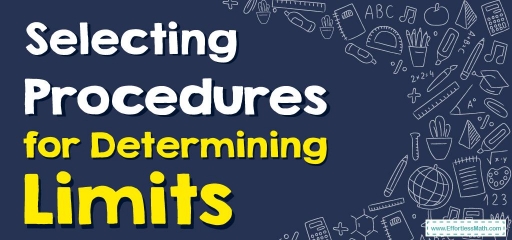How to Select Procedures for Determining Limits?
There are several ways to solve the limit. The following step-by-step guide helps you learn how to select methods for determining limits.

There are many techniques for finding limits that apply in different situations. It is important to know all of these techniques, but it is also important to know when to use which techniques.
Related Topics
- How to Define Limits Analytically Using Correct Notation
- How to Estimate Limit Values from the Graph
- Properties of Limits
A step-by-step guide to select procedures for determining limits
Steps to choosing an appropriate limits determination procedure:
Step 1: Try evaluating the limit at the given location.
Step 2: Pay attention to what occurs when you assess at the given location. One of the following three scenarios will occur:
- When we check at the point, we get a value, and we may specify that the value we get is our limit. For example:
\(lim_{x\to 4}x^2=(4)^2=16\)
- We receive division by zero (an undefined result), which results in a vertical asymptote. For example:
\(lim_{x\to 4}\frac{1}{x-4}=\frac{1}{4-4}=\frac{1}{0}\)
- Alternatively, we may receive an uncertain form, in which case we will go to Step 3. For example:
\(lim_{x\to 4}\frac{x^2-16}{x-4}=\frac{(4)^2-16}{4-4}=\frac{16-16}{4-4}=\frac{0}{0}\)
Step 3: If we have an indeterminate form, we should try to simplify it by factoring, multiplying by the conjugate (which is important when dealing with radical limits), or using trigonometric identities if we have trigonometric functions.
Note: Below is the possible indeterminate forms that you may encounter:
\(\frac{0}{0}\), \(\frac{∞}{∞}\), \(∞-∞\), \(1^∞\), \(0^0\), \(∞^0\), \(0.∞\)
Selecting procedures for determining limits – Example 1:
Choose an appropriate method to determine the following limit, then evaluate the limit using the selected method. \(lim_{x\to 6}\frac{x^2+2x-2}{x+4}\)
First, evaluate the limit at the given location:
\(lim_{x\to 6}\frac{x^2+2x-2}{x+4}\)
\(=lim_{x\to 6}\frac{(6)^2+2(6)-2}{(6)+4}\)
\(=\frac{36+12-2}{10}\)
\(=\frac{46}{10}=\frac{23}{5}\)
Then, observe what happens when you evaluate at the given location. we see that we do not have an indeterminate form. So we might conclude that our limit is:
\(lim_{x\to 6}\frac{x^2+2x-2}{x+4}=\frac{23}{5}\)
Thus, there is no need to move on to Step 3.
Selecting procedures for determining limits – Example 2:
Choose an appropriate method to determine the following limit, then evaluate the limit using the selected method. \(lim _{x\to -1}\left(\frac{x+1}{x^2+3x+2}\right)\)
First, evaluate the limit at the given location:
\(lim _{x\to -1}\left(\frac{x+1}{x^2+3x+2}\right)\)
\(=lim_{x\to -1}\frac{(-1)+1}{(-1)^2+3(-1)+2}\)
\(=\frac{0}{0}\)
Then, observe what happens when you evaluate at the given location. We see the indeterminate form \(\frac{0}{0}\).
We have an indeterminate form and we have a limit involving polynomials. So we should attempt to factor and simplify.
\(lim _{x\to -1}\left(\frac{x+1}{x^2+3x+2}\right)\)
\(=lim_{x\to -1}\frac{x+1}{(x+1)(x+2)}\)
\(=lim_{x\to -1}\frac{1}{(x+2)}\)
\(=lim_{x\to -1}\frac{1}{(-1)+2}\)
\(=1\)
Since we do not deal with anything indeterminate form, we may conclude that our limit is:
\(lim _{x\to -1}\left(\frac{x+1}{x^2+3x+2}\right)=1\)
Exercises for Selecting Procedures for Determining Limits
Evaluate the following limits using an appropriate method.
- \(\color{blue}{lim _{x\to \infty }\left(\frac{\sqrt{x}-4}{x-16}\right)}\)
- \(\color{blue}{lim _{x\to 3}\left(\frac{x-3}{x^2-2x-3}\right)}\)
- \(\color{blue}{lim _{x\to -7}\left(\frac{x^2+7x}{x^2+6x-7}\right)}\)
- \(\color{blue}{lim _{x\to -1}\left(\frac{\sqrt{x+5}-2}{x+1}\right)}\)
- \(\color{blue}{lim _{x\to 4}\left(\frac{x-4}{\sqrt{x+5}-3}\right)}\)

- \(\color{blue}{0}\)
- \(\color{blue}{\frac{1}{4}}\)
- \(\color{blue}{\frac{7}{8}}\)
- \(\color{blue}{\frac{1}{4}}\)
- \(\color{blue}{6}\)
Related to This Article
More math articles
- How to Use Benchmark Fraction? Benchmark Fraction Definition
- 3rd Grade PARCC Math FREE Sample Practice Questions
- Algebra Puzzle – Critical Thinking 11
- Top Calculators for the PSAT 2023: Quick Review
- How to Use Basic Techniques for Solving Trigonometric Equations
- How to Solve Multi-step Addition Word Problems
- How to Find Midpoint? (+FREE Worksheet!)
- The Ultimate 6th Grade LEAP Math Course (+FREE Worksheets)
- Full-Length 7th Grade FSA Math Practice Test
- Quotient Conundrums: How to Estimate Division Using Inequalities


























What people say about "How to Select Procedures for Determining Limits? - Effortless Math: We Help Students Learn to LOVE Mathematics"?
No one replied yet.